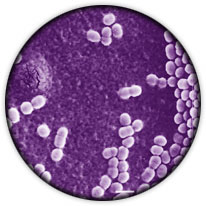Common in the European tradition, cultured butter uses fresh cream to which a culture has been added. These factors provide for a butter that is rich with a fuller, slightly tangy flavor. Cultured butter is less common in America. A common example is the French demi-sel (low salt) butters, which have a small amount of salt added (.33%) less than typical American salted butters which can contain almost 2%. 
If ripening is desired for the production of cultured butter , mixed bacterial cultures are added. The bacteria are from the Bacilli type of Lactobacillales which includes Streptococcaceae (parent of Streptococcus and lactic Streptococcus, called Lactococcus), and Leuconostoc (at right). The culture commonly used mixture for butter is:
- Lactococcus lactis subsp. lactis
- Lactococcus lactis subsp. cremoris
- Lactococcus lactis subsp. lactis biovar. diacetylactis
- Leuconostoc mesenteroides subsp. cremoris (Leuc. citrovorum)
The cream is ripened to pH 5.5 at 21°C and then pH 4.6 at 13°C. Most flavor development occurs between pH 5.5 - 4.6. The colder the temperature during ripening the more the flavor development relative to acid production. Ripened butter is usually not washed or salted.
The cream can be either fresh or slightly soured although slightly soured cream tends to give better results. Cream is soured using a special butter starter and once introduced it is allowed to stand at 21°C for 12 hours. After ripening the cream is cooled to 4.5 to 7°C for several hours to allow the fat to harden. The cream is then allowed to warm to 10 to 18°C, 10°C in the warmer weather and 18°C in cooler weather and is poured into a butter churn.
Virtually all butter in the United States today is sweet cream butter. A notable exception is butter made from whey cream salvaged in the cheese-making process. The quality of fresh whey cream butter is indistinguishable from sweet cream butter.
